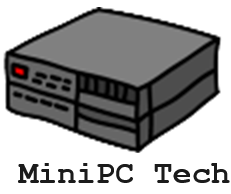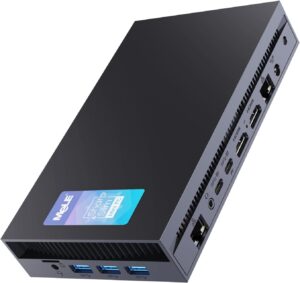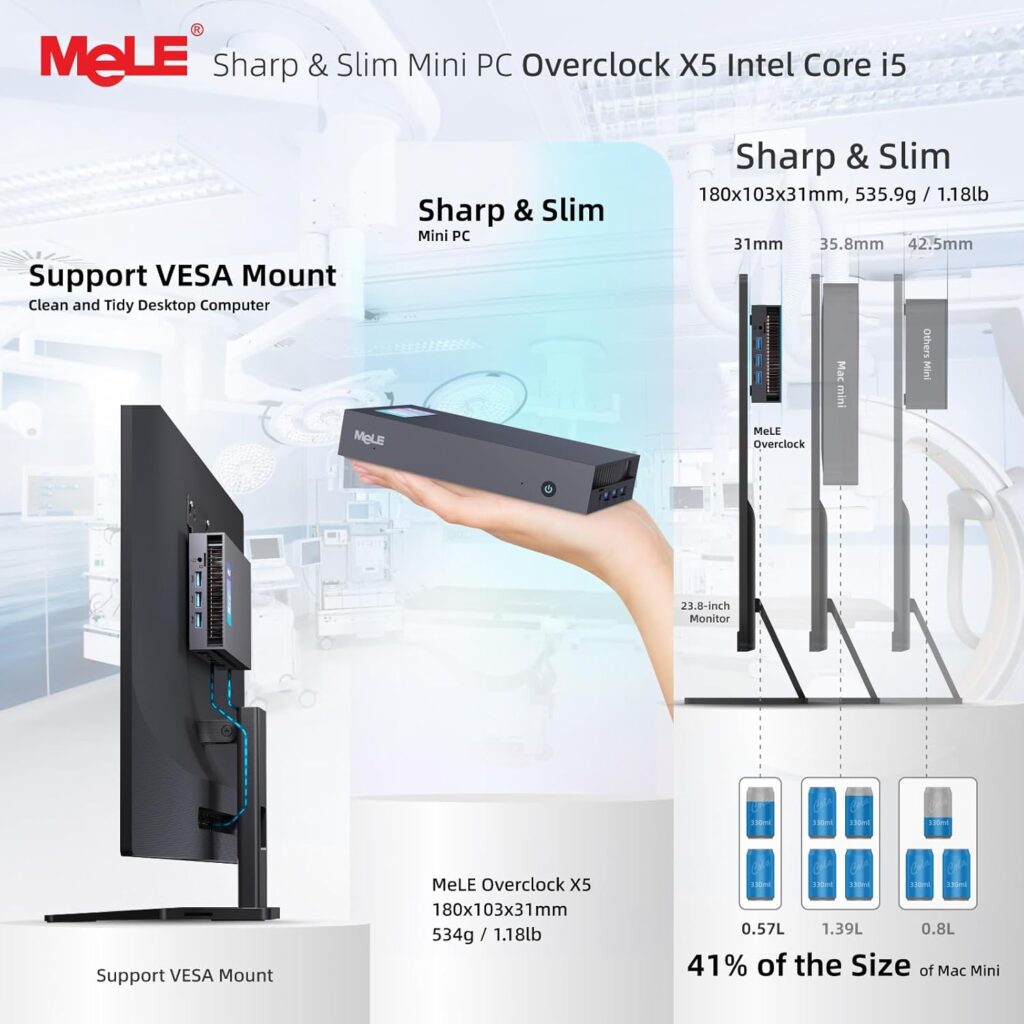
Introduction
The world of mini PCs is booming, offering impressive power in increasingly shrinking packages. Enter the Mele Overclock X5, an ultra-slim contender promising desktop-grade performance thanks to its Intel Core i5-12450H processor running at an enhanced 45W TDP. This isn’t just another small form factor PC; it’s engineered for demanding tasks, boasting quad 4K display support, dual LAN ports including 2.5GbE, and a wealth of connectivity options, all squeezed into a chassis barely larger than a paperback book. But does this “Overclock” moniker translate to real-world gains, and is this the right compact computer for your needs? This review delves deep into the Mele Overclock X5’s performance, features, design, connectivity, and value proposition to help you decide if this mini marvel deserves a place on your desk (or behind your monitor).
There are affiliate links in this post. As an Amazon Affiliate, I might make a small commission on every purchase. No extra cost to you, and it helps to support this blog.
- Powerful Core-i5 12450H Processor - This Mini PC is equipped with a powerful 8-core, 12-thread Core i5-12450H(4P-cores @ 4.4GHz Turbo + 4E-cores @ 3.3GHz Turbo). The precision-engineered Overclock X5...
- High Capacity & Expandable Storage Architecture – This Mini PC is equipped with 16GB DDR4 memory (Support dual-channel via 2× SO-DIMM slots, scalable to 64GB) and a 512GB NVMe SSD (expandable to...
- Quad Display & Versatile Connectivity- Measuring just 180×103×31mm (0.57L), the MeLE Overclock X5 packs quad 4K display outputs into its compact chassis . Engineered for professionals, it boasts...
Key Takeaways: Mele Overclock X5 at a Glance
- Boosted Performance: Features an Intel Core i5-12450H (8 Cores/12 Threads) running at an optimized 45W TDP (PL1), delivering a claimed 24% performance uplift over standard 35W configurations for demanding applications.
- Exceptional Connectivity: Offers quad 4K@60Hz display outputs (2x HDMI 2.0, 2x USB-C w/ DP), dual Ethernet (1GbE + 2.5GbE), multiple high-speed USB ports (including 10Gbps Type-C and Type-A), Wi-Fi 6, BT 5.2, and dual audio jacks.
- Ultra-Compact & Expandable: Boasts a tiny 0.57L volume (180x103x31mm) and VESA mount support, while still offering user-upgradable dual-channel DDR4 RAM (up to 64GB) and dual M.2 slots (1x NVMe PCIe 3.0 pre-installed, 1x SATA available).
- Professional Features: Includes advanced BIOS options like Wake-on-LAN, PXE boot, RTC Wake, Auto Power On, and a Kensington lock slot, making it suitable for business, digital signage, and specialized deployments.
- Solid Storage Foundation: Comes equipped with a fast NVMe SSD (up to 4TB supported) with good read speeds and endurance, plus the option to add a secondary M.2 SATA SSD (up to 2TB).
What Makes the Mele Overclock X5 Stand Out in the Mini PC Market?
The mini PC landscape is crowded, with options ranging from ultra-low-power sticks to surprisingly potent gaming boxes. The Mele Overclock X5 carves its niche by blending potent processing power, usually found in larger systems, with an exceptionally slim profile and professional-grade features. Its most significant differentiator is the implementation of the Intel Core i5-12450H processor. While this 12th Gen Alder Lake chip is powerful in its own right, Mele has specifically engineered the Overclock X5’s thermal module to sustain a higher 45W Power Limit 1 (PL1) compared to the standard 35W configuration often seen in similar-sized devices. This “overclock” isn’t about manual user tweaking in the traditional sense, but rather an optimized power delivery and cooling system designed to let the CPU run faster for longer under sustained load.
Beyond raw power, the X5 distinguishes itself with its focus on connectivity and multi-display capabilities within its ultra-compact 0.57-liter chassis. Offering quad 4K display outputs is rare in this size class, making it immediately appealing for productivity setups, digital signage walls, or monitoring stations. The inclusion of dual Ethernet ports, one being a high-speed 2.5GbE port, further caters to users with specific networking needs, such as those using network-attached storage (NAS), running virtual machines, or setting up custom router/firewall solutions. Combined with its VESA mount compatibility and advanced BIOS features, the Mele Overclock X5 positions itself as more than just a general-purpose mini PC; it’s a versatile tool for power users and specific professional applications demanding performance, connectivity, and a minimal footprint.
Unpacking the Performance: How Powerful is the Intel Core i5-12450H in the Overclock X5?
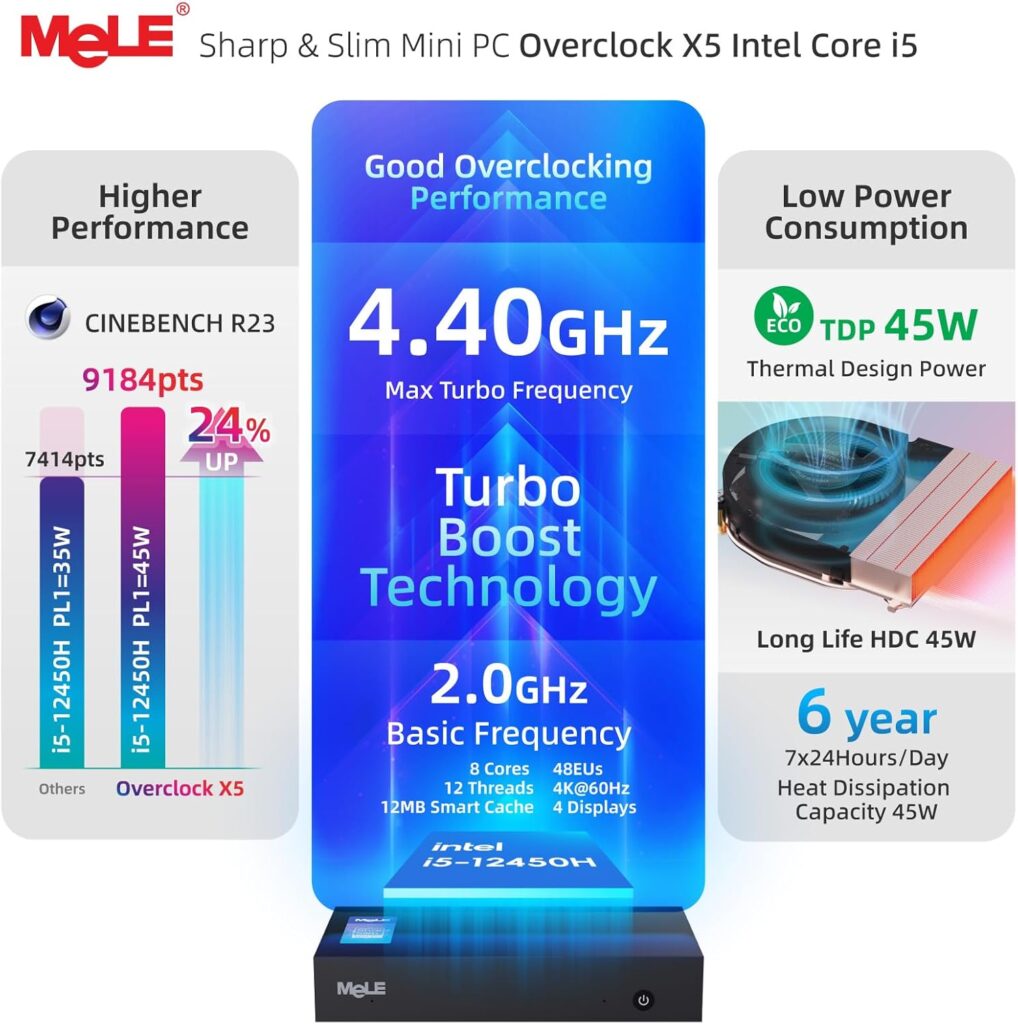
At the heart of the Mele Overclock X5 lies the Intel Core i5-12450H processor. This is a mobile chip from Intel’s 12th Generation “Alder Lake” family, featuring a hybrid architecture: 4 Performance-cores (P-cores) that can boost up to 4.4GHz and 4 Efficient-cores (E-cores) that reach up to 3.3GHz. With a total of 8 cores and 12 threads (P-cores are hyper-threaded, E-cores are not), this CPU is well-equipped for multitasking and demanding productivity workloads. It significantly outperforms older generation i5s and even some i7s from previous generations, offering a substantial leap in both single-core and multi-core performance.
The key performance feature highlighted by Mele is the optimized 45W PL1 configuration. PL1 (Power Limit 1) dictates the sustained power draw the CPU can maintain. By increasing this from the typical 35W to 45W and implementing a cooling solution to handle the extra heat, Mele allows the i5-12450H to maintain higher clock speeds for longer durations under heavy load. Their internal testing claims a 24% improvement in Cinebench R23 multi-core scores (9184 points vs. 7414 points for a 35W system). While benchmark scores provide a good comparison point, this translates to tangible benefits in real-world scenarios like video encoding, running complex spreadsheets, compiling code, or handling multiple virtual machines. The integrated Intel UHD Graphics (48 Execution Units, up to 1.2GHz) are capable for everyday tasks, multimedia playback (including 4K), and light gaming, but aren’t designed for demanding modern AAA titles.
Design and Build Quality: Is the Overclock X5 Truly “Sharp & Slim”?
Mele certainly emphasizes the “Sharp & Slim” nature of the Overclock X5, and the dimensions back this up. Measuring just 180mm long, 103mm wide, and a mere 31mm thick (7.09 x 4.06 x 1.22 inches), it occupies a volume of only 0.57 liters. This makes it significantly smaller than traditional small form factor (SFF) PCs and notably thinner than many popular mini PCs like the Intel NUC or Apple Mac Mini (as highlighted in their comparison graphic). Weighing in at 534 grams (1.18 lbs), it’s lightweight and highly portable. The chassis appears to be constructed primarily from metal, likely aluminum, contributing to a sturdy feel and aiding passive heat dissipation, complementing the internal active cooling fan. The design is minimalist and functional, with clean lines and a dark grey/black finish that should blend easily into most office or home environments.
The slim profile is particularly advantageous for VESA mounting. By attaching the Overclock X5 directly to the back of a monitor using a standard VESA bracket (often included or available separately), you can create an “all-in-one” style setup with zero desk footprint. This is ideal for minimalist desks, kiosks, digital signage installations, or anywhere space is at a premium. The build quality feels solid, appropriate for a device potentially deployed in various environments. While it’s not ruggedized in the military sense, the metal construction and thoughtful port placement suggest durability for typical office or home use. The numerous ventilation grilles on the sides are crucial for the 45W cooling system and indicate that airflow management was a key design consideration.
Connectivity Overload? Exploring the Rich I/O of the Mele Overclock X5
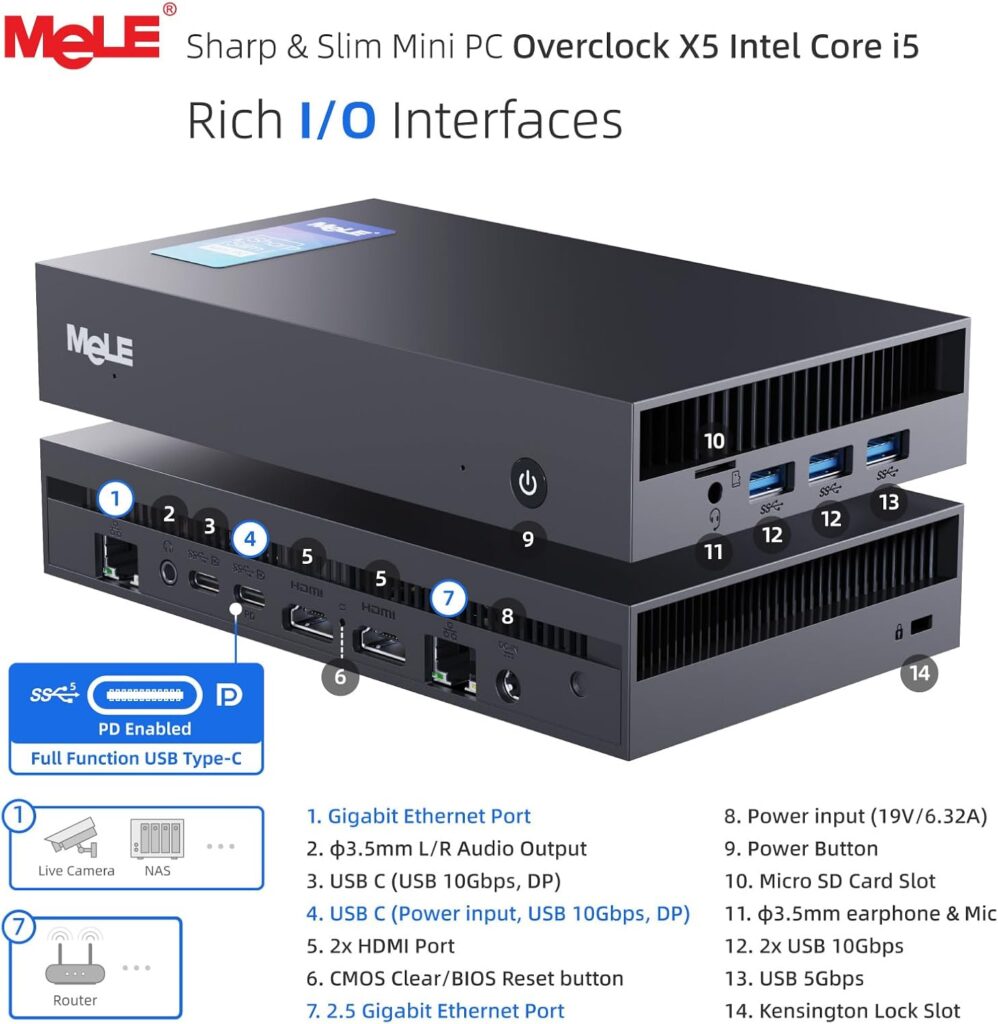
One of the most impressive aspects of the Mele Overclock X5 is the sheer density and variety of its Input/Output ports, especially considering its slim dimensions. Mele hasn’t compromised here, offering a selection that rivals much larger machines.
Front Panel:
- Power Button (with integrated status LED)
- Micro SD Card Slot (UHS-I speeds, USB 2.0 interface – 480Mbps)
- 3x USB 3.2 Gen 1 Type-A ports (5Gbps)
Rear Panel:
- Kensington Lock Slot (for physical security)
- 1x Gigabit Ethernet Port (RJ45, Realtek RTL8111H)
- 1x 2.5 Gigabit Ethernet Port (RJ45, Realtek RTL8125B)
- CMOS Clear / BIOS Reset button (pinhole access)
- 2x HDMI 2.0 ports (supporting 4K@60Hz)
- 2x USB 3.2 Gen 2 Type-A ports (10Gbps)
- 1x USB 3.2 Gen 2 Type-C port (10Gbps, supports Power Delivery input, DisplayPort Alt Mode 4K@60Hz)
- 1x USB 3.2 Gen 2 Type-C port (10Gbps, supports DisplayPort Alt Mode 4K@60Hz – No PD input on this one)
- 3.5mm L/R Audio Output jack
- 3.5mm Headphone & Microphone Combo jack
- DC Power Input (19V/6.32A)
This comprehensive array covers nearly every conceivable need for a modern workstation or specialized deployment. The inclusion of two 10Gbps USB-C ports (one with PD input flexibility) and two 10Gbps USB-A ports ensures high-speed connectivity for external drives and peripherals. The dual LAN ports are a standout feature for networking enthusiasts or specific business applications. Having both dedicated audio out and a combo jack adds flexibility for audio setups. The only minor limitation is the Micro SD card slot operating at USB 2.0 speeds, making it more suitable for occasional use than high-speed data transfer.
Quad Display Dominance: Can the Overclock X5 Handle Multiple 4K Monitors?
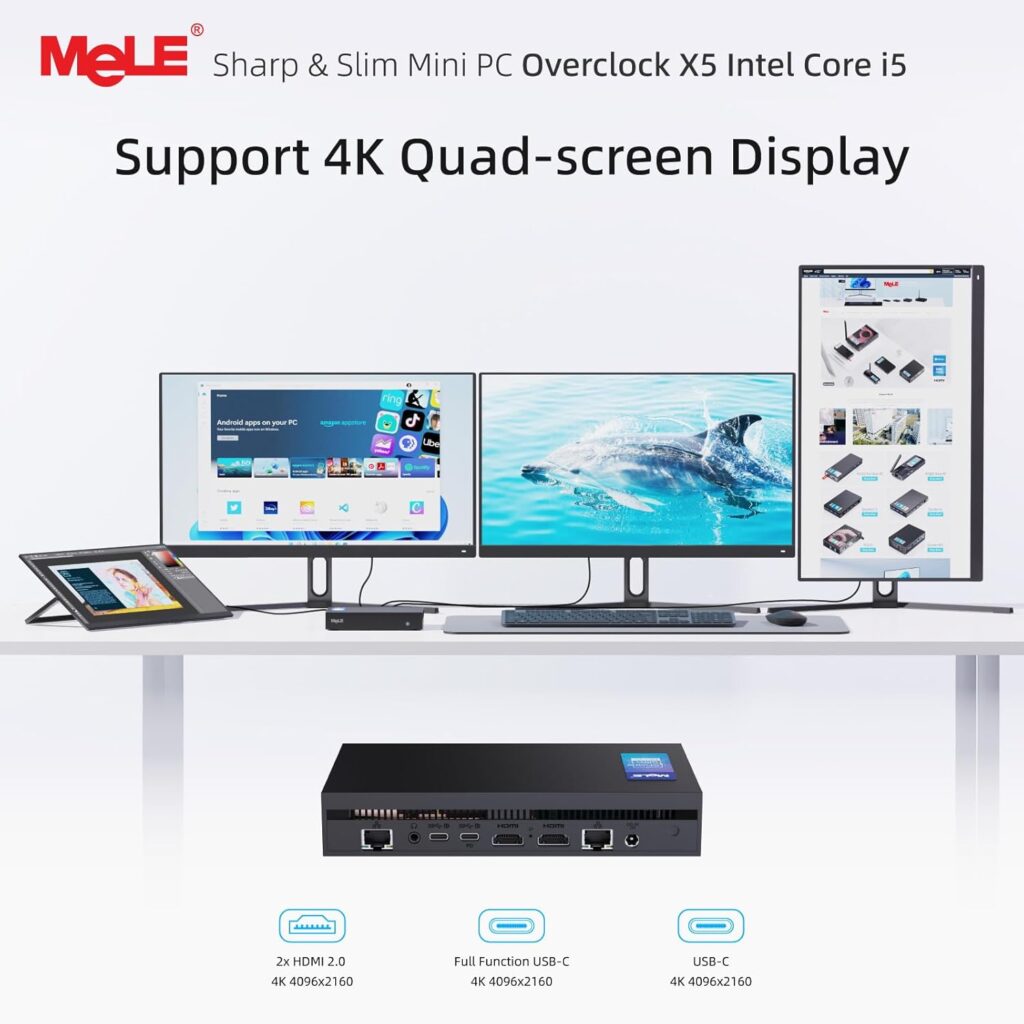
Yes, the Mele Overclock X5 is explicitly designed to support up to four independent displays simultaneously, each running at a maximum resolution of 4K (4096×2160 or 3840×2160) at a 60Hz refresh rate. This is achieved through its combination of video outputs:
- 2x HDMI 2.0 ports
- 2x USB-C ports with DisplayPort Alt Mode support
The Intel UHD Graphics integrated into the Core i5-12450H processor are responsible for driving these displays. While not a powerhouse for 3D gaming across four screens, these graphics are more than capable of handling demanding productivity tasks spread across multiple high-resolution monitors. This makes the Overclock X5 an excellent choice for financial traders, software developers, graphic designers (for 2D work), content creators managing multiple feeds, or anyone who benefits from expansive screen real estate.
Setting up a quad-display configuration requires monitors with compatible inputs (HDMI or DisplayPort via USB-C adapters/cables if necessary). The ability to drive four 4K displays from such a tiny device is a significant advantage, enabling complex workflows and enhanced multitasking without the need for a bulky desktop tower or expensive docking stations. This feature alone makes the Overclock X5 highly competitive for professional environments where multi-monitor setups are standard.
Storage and Memory: Is the Mele Overclock X5 Upgradable and Future-Proof?
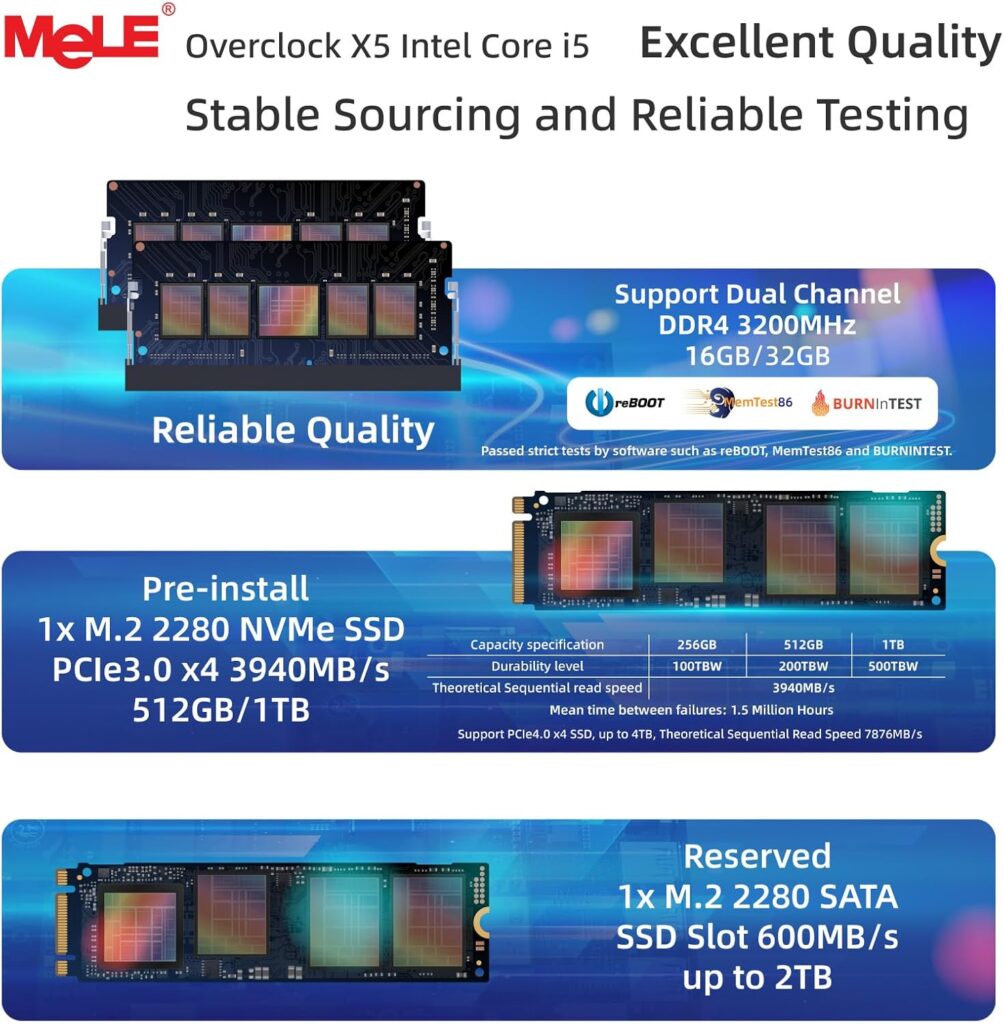
The Mele Overclock X5 offers a good degree of user upgradability for both memory and storage, enhancing its longevity and flexibility. It ships typically configured with 16GB of DDR4 RAM (running at 3200MHz), installed as either a single module or dual modules depending on the specific SKU purchased. Crucially, it features two SO-DIMM slots supporting dual-channel memory configurations. Users can upgrade the RAM up to a maximum of 64GB (2x 32GB modules), providing ample headroom for memory-intensive applications, virtualization, or heavy multitasking.
For storage, the Overclock X5 comes pre-installed with one M.2 2280 NVMe SSD utilizing a PCIe 3.0 x4 interface. Common configurations are 512GB or 1TB. Mele quotes sequential read speeds up to 3940MB/s for the included drive, which is excellent for fast boot times and application loading. This primary NVMe slot supports drives up to 4TB. Additionally, and importantly for expansion, there is a reserved M.2 2280 slot designed for a SATA III SSD. This second slot allows users to easily add more storage (up to 2TB supported) without replacing the primary OS drive. While SATA speeds (max 600MB/s) are slower than NVMe, it’s perfect for storing large media files, documents, backups, or less frequently accessed applications. Accessing these slots usually involves removing the bottom panel of the mini PC. This combination of upgradable RAM and dual M.2 slots (one NVMe, one SATA) makes the Overclock X5 quite flexible and relatively future-proof in terms of core components.
Networking Prowess: Dual LAN, Wi-Fi 6, and Bluetooth 5.2 Explained
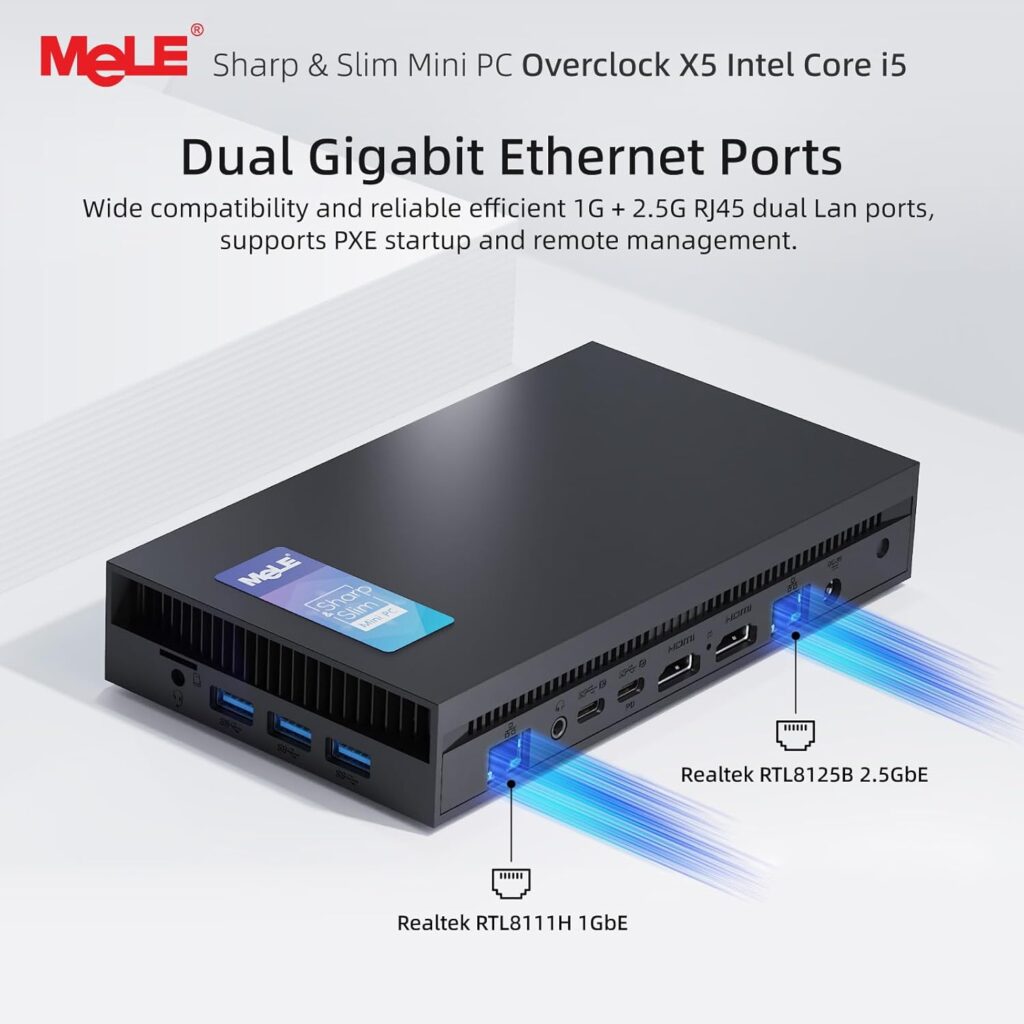
Networking is another strong suit of the Mele Overclock X5. It caters to both high-speed wired and modern wireless connections. The inclusion of dual Ethernet ports is a key feature for power users and specific applications. It includes:
- 1x 2.5 Gigabit Ethernet (2.5GbE) port: Powered by the Realtek RTL8125B controller, this port offers significantly faster wired network speeds than standard Gigabit Ethernet, provided you have compatible network infrastructure (router, switch). This is beneficial for transferring large files quickly to/from a NAS, high-speed internet connections exceeding 1Gbps, or demanding network applications.
- 1x Gigabit Ethernet (1GbE) port: A standard Realtek RTL8111H Gigabit port, providing reliable wired connectivity for general use or as a secondary network interface (e.g., connecting to a separate network segment, using the PC as a router/firewall).
For wireless connectivity, the Overclock X5 is equipped with Wi-Fi 6 (802.11ax). This latest Wi-Fi standard offers higher theoretical speeds, improved efficiency (especially in crowded Wi-Fi environments), lower latency, and better overall performance compared to Wi-Fi 5 (802.11ac). It supports dual-band operation (2.4GHz and 5GHz) for flexibility. Alongside Wi-Fi, it incorporates Bluetooth 5.2, providing improved range, speed, and connection stability for wireless peripherals like keyboards, mice, headphones, and speakers, as well as better energy efficiency. This robust networking package ensures fast and reliable connections whether wired or wireless, catering to a wide range of home, office, and specialized networking scenarios.
BIOS Features and Management: Who is This Mini PC For?
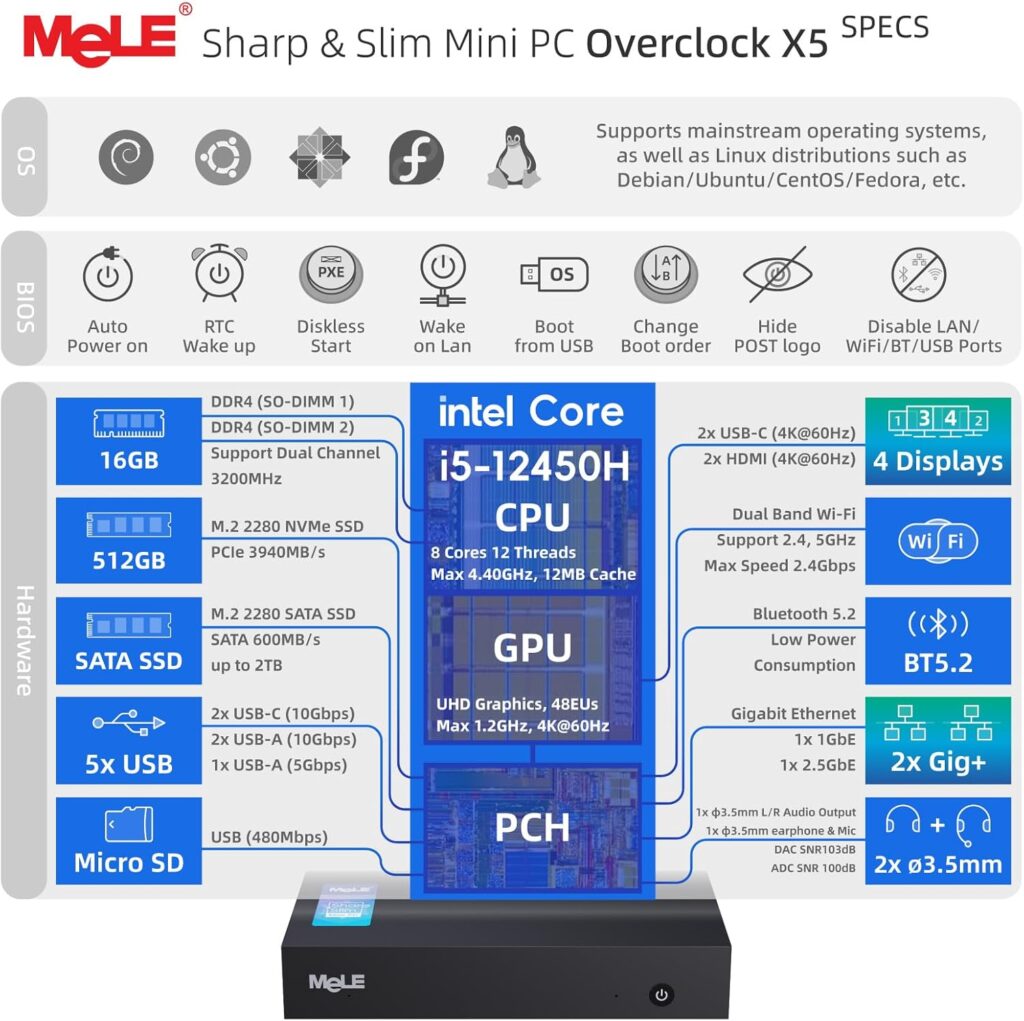
(Image Recommendation: Use the sixth image – the SPEC sheet showing OS/BIOS/Hardware details.)
Alt-Text: Specification sheet for the Mele Overclock X5 detailing supported OS (Windows, Linux), BIOS features (Auto Power On, RTC Wake, PXE), and hardware components like CPU, RAM, SSD, Wi-Fi, and Ports.
While powerful and compact enough for general home users, the Mele Overclock X5 includes several BIOS-level features and physical security options that clearly target professional, business, and embedded applications. The BIOS offers granular control often absent in consumer-grade mini PCs:
- Auto Power On: Allows the PC to automatically boot up when power is supplied, essential for unattended systems like kiosks or digital signage players that might experience power interruptions.
- RTC Wake: Enables scheduled power-on times based on the Real-Time Clock, useful for automated tasks or ensuring systems are ready at specific times.
- Wake on LAN (WoL): Allows the PC to be powered on remotely over the network, crucial for IT administrators needing to manage machines without physical access.
- PXE Boot (Preboot Execution Environment): Enables booting the PC from a network server, commonly used in enterprise environments for deploying operating systems or diskless workstations.
- Configurable Boot Options: Standard controls for boot order, booting from USB, etc.
- Option to Disable Devices: Ability to disable specific hardware like Wi-Fi, Bluetooth, or individual USB ports directly in the BIOS for enhanced security or specific configurations.
- Unlocked BIOS: Mele mentions an unlocked BIOS, suggesting potentially more advanced tweaking options might be available for experienced users (though proceed with caution).
Furthermore, the inclusion of a Kensington Lock Slot provides a physical security measure against theft in public or semi-public environments. Combined with its robust build, quad-display support, dual LAN, and reliable performance, these management and security features make the Overclock X5 highly suitable for digital signage controllers, thin clients in VDI environments, surveillance system NVRs, small office servers, custom router/firewall appliances (leveraging the dual LAN), and workstations in professional settings where remote management and reliability are key.
- Powerful Core-i5 12450H Processor - This Mini PC is equipped with a powerful 8-core, 12-thread Core i5-12450H(4P-cores @ 4.4GHz Turbo + 4E-cores @ 3.3GHz Turbo). The precision-engineered Overclock X5...
- High Capacity & Expandable Storage Architecture – This Mini PC is equipped with 16GB DDR4 memory (Support dual-channel via 2× SO-DIMM slots, scalable to 64GB) and a 512GB NVMe SSD (expandable to...
- Quad Display & Versatile Connectivity- Measuring just 180×103×31mm (0.57L), the MeLE Overclock X5 packs quad 4K display outputs into its compact chassis . Engineered for professionals, it boasts...
Reliability and Testing: Can You Trust the Mele Overclock X5 for Demanding Use?
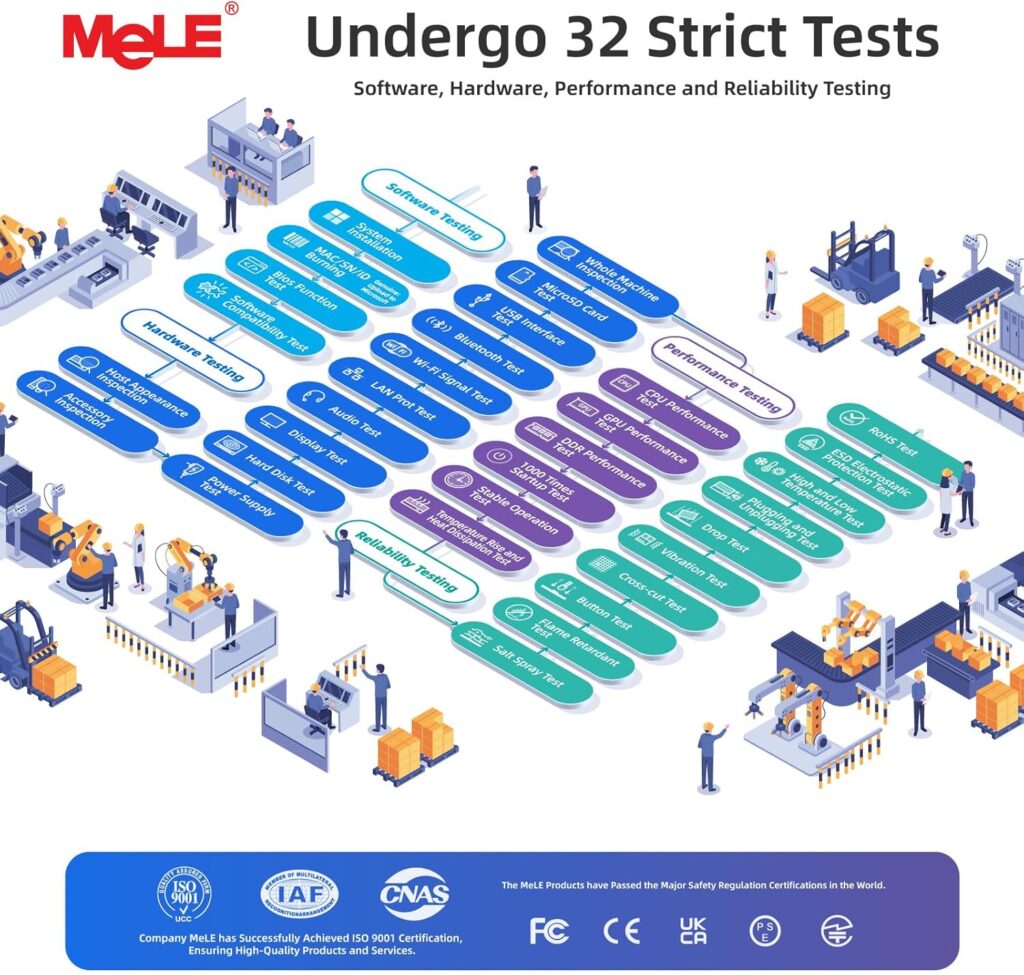
Mele emphasizes the reliability and quality control behind the Overclock X5. While any mass-produced electronic device can potentially have issues, Mele highlights several points suggesting a focus on durability and stable operation, particularly important given the higher 45W TDP target. They mention subjecting the mini PC to 32 strict tests covering software, hardware, performance, and reliability. Specific tests mentioned include reBOOT, MemTest86, and BURNINTEST, which are industry-standard tools for verifying system stability and memory integrity under stress.
The manufacturer also points to “Stable Sourcing and Reliable Testing” and mentions compliance with major safety and regulatory certifications like FCC, CE, UKCA, and PSE, along with ISO 9001 certification for their quality management systems. The design itself, with ample ventilation and a metal chassis, suggests an effort to manage the heat generated by the 45W i5-12450H. Mele even references a “Long Life HDC 45W” design intended for 7×24 hours/day operation, implying confidence in the thermal solution’s ability to handle sustained loads.
While long-term, real-world user reports are the ultimate judge of reliability, the steps Mele outlines – comprehensive testing, certifications, and a seemingly robust thermal design – indicate a commitment to producing a stable and dependable mini PC capable of handling the performance it promises, even in continuous operation scenarios typical of commercial or professional deployments. The quality of the components used, such as the NVMe SSD with specified endurance ratings (e.g., 200TBW for the 512GB model), also contributes to the overall reliability picture.
Frequently Asked Questions
What Operating System comes with the Mele Overclock X5?
It typically ships with Windows 11 Pro pre-installed. However, it officially supports various Linux distributions like Ubuntu, Debian, CentOS, and Fedora, making it versatile for different OS preferences. Check the specific listing, as barebones versions might be available.
Can the Mele Overclock X5 run games?
The integrated Intel UHD Graphics can handle older titles, esports games (like League of Legends, CS:GO) at lower settings, and casual gaming. It is not suitable for playing demanding modern AAA games at high settings or resolutions. Its strength lies in productivity and multimedia.
Is the Mele Overclock X5 fanless?
No, the Mele Overclock X5 is not fanless. Due to the higher 45W TDP of the Core i5-12450H processor, it requires an active cooling solution (a fan and heatsink) to maintain performance and prevent overheating under load. Fan noise will be present, likely varying with system load.
How much power does the Mele Overclock X5 use?
It comes with a 19V/6.32A power adapter, which translates to a maximum theoretical power draw of around 120W for the adapter. The CPU’s PL1 is 45W, and PL2 (short bursts) might be higher. Actual power consumption will vary significantly depending on the workload, ranging from low single digits at idle to potentially 60-80W+ under heavy synthetic load.
What’s typically included in the box with the Mele Overclock X5?
Generally, you can expect to find the Mele Overclock X5 Mini PC itself, the AC power adapter and power cord, a VESA mounting bracket with screws, and a user manual. An HDMI cable may sometimes be included, but verify with the seller.
Conclusion: Why Choose the Mele Overclock X5 Mini PC?
(Image Recommendation: Use the second image – the sleek angled product shot.)
Alt-Text: The Mele Overclock X5 Ultra Slim Mini PC shown from an angle, emphasizing its compact and professional design suitable for various environments.
The Mele Overclock X5 Ultra Slim Mini PC stands out as a compelling option for users seeking a potent blend of performance, connectivity, and compactness. Its key strength lies in harnessing the power of the Intel Core i5-12450H processor more effectively than many competitors, thanks to its optimized 45W thermal design, delivering tangible performance gains for demanding tasks. This processing power, combined with support for up to 64GB of RAM and fast NVMe storage (plus expansion options), makes it a capable workstation replacement for many users.
Where the Overclock X5 truly shines is in its versatility. The ability to drive four 4K displays simultaneously is exceptional for its size. The comprehensive I/O, including dual LAN (with 2.5GbE), multiple high-speed USB ports, Wi-Fi 6, and dual audio jacks, ensures it can connect to virtually anything you need. Add the professional BIOS features (WoL, PXE, Auto Power On, RTC Wake) and VESA mount capability, and it becomes clear this mini PC is engineered not just for general use, but also for specialized applications in business, digital signage, networking, and development.
If you need maximum CPU performance in the smallest possible footprint, require extensive multi-monitor support, demand versatile and high-speed networking, or need advanced management features for deployment, the Mele Overclock X5 is a powerful and feature-rich contender that punches well above its weight class. While not a gaming machine or a fanless silent PC, it offers a unique combination of capabilities that make it an excellent investment for professionals, power users, and businesses looking for a compact, capable, and connected computing solution.

I am a retired software engineer with experience in a multitude of areas including managing AWS and VMWare development environments. I bought a relative a mini-PC a year ago and have become passionate about the technology and its potential to change how we deploy software.
